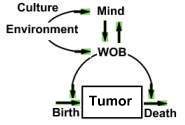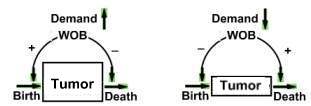
 |
Before reading this chapter please start with:
First concepts
WOB is optimal
A simple model
Tumor (neoplasm) is the hallmark of cancer. It is assumed
here that it produces a substitute for a vital substance (VS)
required by the organism. Tumor size is driven by
a demand for this vital substance (VS)
by organism, and is controlled
by WOB. Tumor size depends on birth
and death rates of its cells. When demand for VS is
high, tumor cell birth rate rises, death rate declines, and tumor
grows. When demand declines tumor cell birth rate declines, death rate rises,
and tumor shrinks.
 |
 |
Solution
WOB controls all processes and
adjusts them so as to meet the requirements of the organism. WOB responds
also to the mind, which receives signals and directives from society (culture).
The adjustment of processes at any instant is called WOB solution.
It is always the most optimal solution
in circumstances. This is the
modern interpretation of Galen’s principle: Nothing
is done by Nature in vain.
Tumor growth
This optimality principle underlies
also the cancer evolution. At any instance WOB adjusts tumor cell production
to the demands of the organism for VS, and is most optimal.
Lack of VS results in cachexia.
Cancer proceeds through three phases:
1. Full compensation when tumor cell birth and death rates are high and equal,
and tumor is small, and patient feels
healthy (WOB does not complain).
2. Decompensation, when tumor cell birth and death rates are high and death
rate is lower than birth rate. Tumor
seeds metastases and becomes visible. Patient feels sick, and suffers from
secondary manifestations due to tumor invasion into other tissues.
3. Total decompensation: Extensive cachexia.
Rising demand for VS by the
organism drives the disease. VS nature and the causes of its depletion
are still unknown, however it is assumed
here that VS
deficiency promotes cachexia.
Full compensation
Cancer starts with rising tumor cell birth and death rates. Initially
they are equal and tumor is small (pre-clinical phase). As organism requires
more and more VS substitute, tumor starts growing.. Clinical manifestations
are interpreted from WOB perspective. In order to diminish demand for
VS WOB catabolizes tissues, patient loses weight, and disease enters its
second phase. WOB main task is to prevent cachexia, and when it fails
tumor grows faster.
Decompensation
VS deficiency continually deepens. In order to raise
VS substitute production tumor
seeds metastases. They settle in the connective tissue of organs where they
grow without damaging organ
function. Favored sites are retroperitoneum, mediastinum, and bone marrow. As they continue growing occasionally
one will damage an organ, and WOB sends to mind a
pain signal, as if saying: "Get help to correct the damage!"
All along disease progression, WOB solution remains
the most optimal under circumstances.
In order to keep the patient alive it has to nurture metastasis and give
up peripheral processes, otherwise patient will die from cachexia. WOB
task is to maintain life at all cost.
Even cachexia may be regarded as WOB effort to reduce the demand for VS.
Therapy
WOB solutions do not meet patient's (mind) expectations,
who insists on a better life. Physician
has two main responsibilities: To help where WOB failed, and to improve
patient's quality of life. All this
without interfering too much with WOB solutions. He has to work out a compromise between WOB
and mind demands. Since patient cannot be cured, the main objective is to slow
down disease progression. The two major threats to the patient are
tumor and metastasis. Any attempt
to diminish tumor mass promotes cachexia and endangers the patient.
Physician ought therefore attempt to lower demand for VS.
During sleep demand
for all metabolites as well as VS is low. Patient
should therefore be encouraged to sleep at least eight hours. He may have
to learn how to sleep that long. A meditating patient may attain a
sleep like condition while maintaining his full consciousness. His
muscles relax, heart beats slower, and so is breathing, and VS demand declines. Meditation has yet another advantage. Patient
learns how to manage his worries and ignore the negative impact on himself by society and culture. This
condition is called mind-cancer. It
raises VS demand, and is discussed elsewhere. Meditation introduces the
patient to a new life. From now on his mission is to learn how to
slow down cancer progression.
Sport
Is risky, yet with some advantages.
Body building may not be advised since it increases demand for VS. Aerobic exercises may be
helpful, since organism learns how to function efficiently and utilize less VS.
Diet
Obesity utilizes energy and VS. Reducing weight slows
down cancer progression. This may seem odd, since weight loss accompanies cancer and one is inclined to
replenish lost calories. Let's
remember that all cancer manifestation are part of a WOB solution, and so
is weight loss. At any instant
WOB adjusts weight in an optimal fashion, and rejects any excess. Indeed
efforts to over feed the patient,
or apply hyperalimentation, fail.
WOB handles also obesity, however
from physician's perspective, weight loss reduces demand for VS and slows
down cancer progression. Any weight reduction diet is a compromise between WOB
and mind demands.
Alternative healers apply many kinds of diet, e.g. Ann
Wigmore's, or macrobiotics, which seem promising, and ought therefore be tested for their capacity
to reduce VS demand by the organism.
The ultimate test would be whether a diet slows down cancer progression.
Chemotherapy
Has to be a last resort measure since tumor reduction promotes
cachexia. To a lesser extent chemotherapy kills also normal cells and reduces
demand for VS. This effect is more pronounced in tamoxifen, which induces
ovarian ablation (castration),
hypotrophy of estrogen target organs, and lowers demand for VS. Although tamoxifen may
slow down cancer progression it has undesired side effects, like uterine
cancer, which indicates that tamoxifen may promote cachexia. One might therefore prefer surgical ablation of the ovary instead.
Aggressive chemotherapy is extremely dangerous, and WOB
protects itself by making chemotherapy less and less effective, which is
known as resistance to chemotherapy.
Pernicious
cachexia
Cancer
is a metabolic deficiency
Cancer-yogi
Cancer-yogi-1
Back to New Medicine